|
Travelogue and Airshow 2004
Warbirds Over Wanaka
by Colin
Ford
|
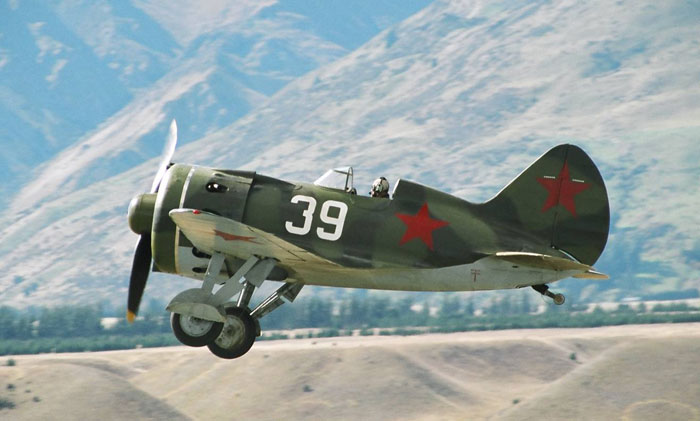 |
|
The stubby, tubby and oh-so-noisy
Polikarpovs proved to once again be a great crowd pleaser. Their engine
noise has been described as a "sewing machine on steroids”. Here
one of the I-16s gets into the air. |

HyperScale is proudly supported by Squadron
I recently returned from a most enjoyable fortnight’s tour of the southern
island of New Zealand, which included attendance at the ‘Warbirds Over Wanaka’
International Airshow for 2004. The tour my family and I joined had been
organised by Ley Reynolds of Platypus Publications of Australia in conjunction
with APT Tours. It had an emphasis on the warbirds airshow, but also other
opportunities to visit other places of interest to the aviation enthusiast.
|
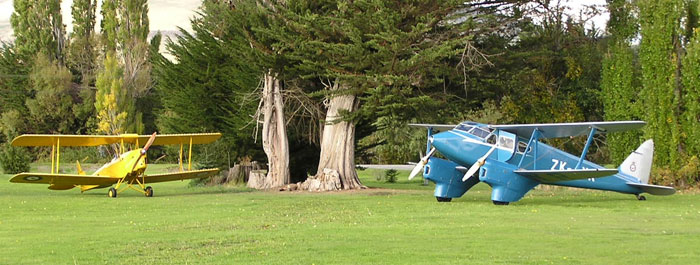 |
|
Early morning at Mandeville and
the Croydon Aircraft Company – the Tiger Moth and Dragon Fly await their
first flights for the day. |
After arriving in Christchurch New Zealand, there was a bit of spare time to
allow everyone to settle in before the tour set off. Some took the opportunity
the first weekend to visit the RNZAF Museum at Wigram, whilst others scoured the
local hobby and book shops. Our tour eventually ended up only having fourteen
people on it, so we had a very large and well equipped tour coach all to
ourselves. Amongst our tour party we had Dr Roger Wallsgrove of Mushroom
Publications (“Do we have a Wodger??”) and my brother-in-law Sydney APMA and
IPMS member Dave Richardson, along with Graham, Greg and Gerald (all aviation
nuts) with assorted spouses and one child – my son Andrew aged four and a half!
Our first overnight stop was in Dunedin and we made our way there via the lakes
region of the south island. From Dunedin we then worked our way to Gore for our
next overnight stop, ready for the following day’s activity.
Our first major aviation stop was at the Croydon Aircraft Company located at Old
Mandeville Airfield, just outside Gore and on the road to Te Anau and
Queenstown. The Croydon Aircraft Company are the de Havilland aircraft
restoration experts in New Zealand (dare I say in the southern hemisphere?).
Here we had the opportunity to partake in flights in their Tiger Moth, Dominie
(Dragon Rapide) or Dragon Fly. Which we did on a morning perfect for flying and
photography. We also had the opportunity to look through their restoration
facilities and to see the aircraft currently being restored. All manner of d.h.
biplanes abounded, as did a couple of Chipmunks and the odd one out, being a
glorious red Beech Staggerwing. A great side attraction is The Moth Restaurant,
which makes great coffees, hot chocolates and cakes and slices – perfect way to
round off the morning after a flight in a d.h. biplane!
|
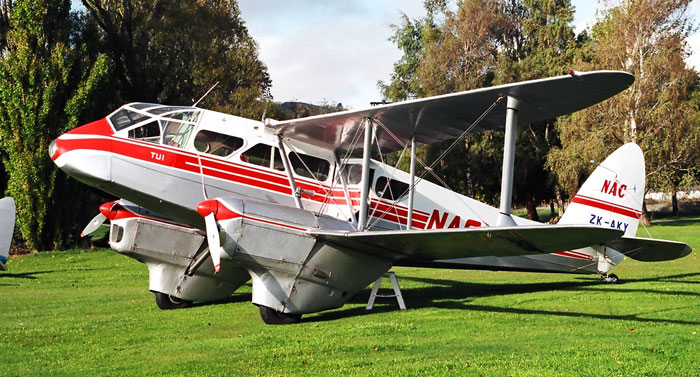 |
|
The de Havilland Dominie (Dragon
Rapide) at Mandeville, one of the smoothest and enjoyable flights I’ve
ever had. |
After the stop to visit the Croydon Aircraft Company, we then made our way to Te
Anau, checking out the local sights, which include amazing scenery, as well as
deer and emu farms along the way. An overnight stay at Te Anau, gave us time to
visit the glow worm caves at Te Anau, which is a great cave system and natural
environment and involves a pleasant boat ride across Lake Te Anau. From Te Anau
we set off for Milford Sound enroute to Queenstown. We took the ‘Red Boat’
cruise of Milford Sound, again seeing some stunning scenery, which consumed more
film and camera memory. My son Andrew even had a chance to sit in the Captain’s
chair are steer the cruise boat via its side stick controller.
Queenstown was our base of operations for ‘Warbirds Over Wanaka’ being the
major accommodation centre for the region, as well as home to its own
attractions.
|
Warbirds Over Wanaka 2004 |
Good Friday was the first day of ‘Warbirds’ being the ‘practice’ day. We all
had Gold Club passes so had access to the flight line a certain times during the
day, grandstand seating and a number of other benefits. A number of aircraft
were still arriving in during the Friday, and the day was taken up with many of
the flying participants checking out their aircraft and routines. It was a
glorious day weatherwise, and the crowds weren’t as big as could be expected on
the following days, so every opportunity for photography was taken. The
Breitling Fighters were performing their final airshow display before
disbanding, so they spent a fair bit of the Friday getting their aircraft into
top condition and getting their flying sequences for the airshow finalised. The
practice sessions were also used by the airshow organisors to get air to air
footage for use in their video and dvd of the airshow, using a specially
equipped Squirrel helicopter equipped with an amazing gyroscopically stabilised
camera system. Passenger flights were also available during the day in a number
of aircraft, including a Catalina and the Warbird Dakota ZK-DAK, which I happily
forked out my money for and had a great flight over the Wanaka area. There were
also more than enough opportunities for some serious aviation ‘retail therapy’
with all manner of books, model aircraft, prints, paintings, event souvenirs,
even through to full size 1:1 scale aircraft. By the end of the day, all of us
who had attended the practice day returned back to our hotel tired and greatly
anticipating the following day’s full air show.
Saturday morning up early and on the road to Wanaka, to arrive to find a much
larger crowd already in attendance than the previous day. The airshow was
everything an aviation enthusiast could hope for, with aircraft from WW1 replica
biplanes and a triplane, through a full range of WW2 aircraft, onto post war
jets, current RNZAF aircraft, plus a good sprinkling of current aircraft from
the civilian charter, agricultural and competition aerobatic aircraft. On the
ground, even more aircraft had arrived overnight, adding to the static display
parks and even more photographic opportunities.
|
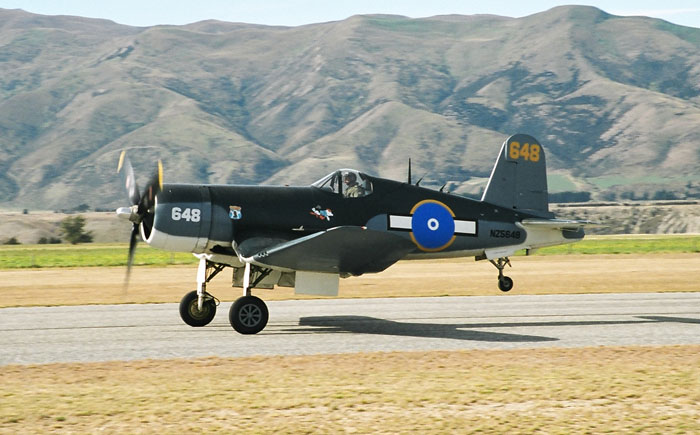 |
|
One of the stars of the show the
’Kiwi’ FG-1D Corsair whose engine note was a marked contrast to the
sound of the inline engines of the other three of the quartet. |
A full day’s flying program followed, with a number of impressive flying and
aircraft handling displays being performed. At times bad weather threatened to
disrupt proceedings, but the weather held off, but did provide the backdrop for
some evocative photography. Notable flying performances from my perspective were
the crop dusting trio of Crescos from Wanganui Aero Works, the handling display
by the RNZAF’s new Boeing 757, the RNZAF C-130 Hercules display (setting off car
alarms in the car park), the Breitling Fighters quartet (P-40 Kittyhawk/Warhawk,
P-51D Mustang, Chance Vought FG-1D Corsair and Supermarine Spitfire Mk.XVI), the
Polikarpovs, the WW1 dogfight scenario, the dis-similar jet foursome (comprising
Cessna A-37 Dragonfly, L.39 Aero Albatros and two d.h. Vampire trainers) and the
incredible aerobatics display by Lithuan pilot Jurgis Kairys in his SU-31. As
always, the finale of the day was the ‘air raid’ by a horde of ‘enemy’ Harvards,
which coincided with a ground attack by ‘enemy’ forces from the Wanaka Warhorses
(military ground forces) which was beaten off with many large and impressive
pyrotechnic explosions.
One moment of tension during the Saturday was when the Lavochkin LA-9 suffered a
failure of its rudder trim tab not long after take off to start its display, but
a precautionary flyby and visual check by the Hurricane revealed the problem and
the Lavochkin was able to safely land back at Wanaka – but without doing its
full planned flight display. After overnight repairs the Lavochkin was able to
conduct a full display routine on the Sunday.
|
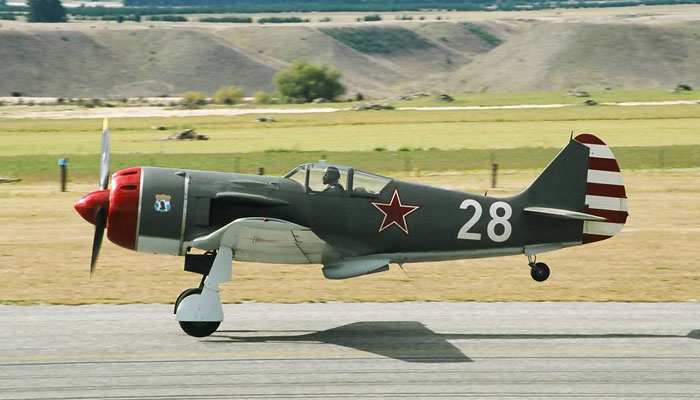 |
|
The oh-so-fast and totally
different engine note Lavochkin LA-9. It was one of the standouts of the
show, not the least for the fact that it something quite unique. Caught
here just at the point of takeoff at Wanaka. |
Many rolls of film and megabytes of digital camera memory expended later, the
day drew to a close.
Sunday was very much a repeat of the Sunday’s program, but with the repaired
Lavochkin able to perform its full planned flying routine. Again the Breitling
Fighters took centre stage for their final display performance together as a
team, producing fine formation and individual flying displays.
Monday was a supposed to be a rest day, for everyone to recover, but most took
advantage of the many attractions of Queenstown, some going jet boating to LOTR
country, others taking full day excursions into the surrounding countryside, or
in my families case, taking a ride on the ‘Kingston Flyer’ a restored steam
train running between Kingston and Fairlight to the south of Queenstown. Nothing
like the smell of coal fired steam along with the sights and sound of steam
travel. The evening was full too, heading across the lake at Queenstown on the
Twin Screw Steamer Ernslaw for a night of dining and rural life demonstrations.
The TSS Ernslaw is interesting in that from the main passenger area, you can
look down into the engine room, watch the engines working away, and the stokers
shovelling coal into its boilers. Great stuff.
Tuesday we left Queenstown and headed for Greymouth on the western coast of the
south island. We headed their via a quick visit to Fox Glacier and a glance at
Franz Josef Glacier. Overnight at Greymouth, and to my four year old sons great
joy, a great find the next morning in the local toy shop, a ‘Thunderbird 5’ to
complete his Thunderbird toy collection (these have not been seen in Australia
for some time). I was pretty happy too finding a model kit I had been looking
for some time on their shelves at a great price.
Wednesday took us to Nelson, the major population centre on the north western
corner of the south island, and more ‘retail therapy’ and searching of hobby/toy
and book shops. Nelson also placed us ready for the next day’s visit to the
Omaka Fighter Collection.
|
The Omaka Fighter Collection |
|
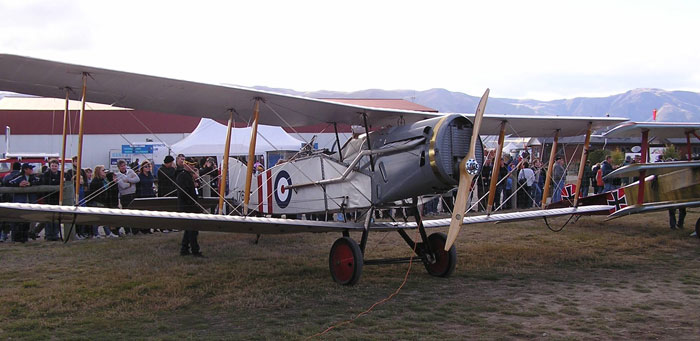 |
|
The replica Bristol Fighter from
the Omaka Fighter Collection, here seen during its attendance at Wanaka.
During its display on the Sunday it broke its tail skid on landing which
required some hasty repairs and recovery work to allow it to move off
the landing area. |
Thursday morning and we were on the road early from Nelson towards Blenheim. The
Omaka Fighter Collection is located just outside Blenheim at Marlborough. By
chance this is deep in good winery country, as well as a quilting and craft
country. So half the tour was dropped off at a quilting and craft centre
adjacent to a winery, and the other half went on to explore things of a WW1
aviation nature. We were warmly welcomed to their restoration and maintenance
facility, where the sights and smells of the earliest days of aviation met our
senses. They have quite a wide and varied range of WW1 replica aircraft under
their care, as well as a number of original WW1 aircraft used as full size
templates for restoration or new build purposes. Here is the ultimate in scratch
building, and the quality of work being done was most impressive. They had just
received the news of a funding grant to allow them to build a new purpose build
museum to house the collection and provide a base of operations for the future.
This will be going ahead and should be built and occupied in the next few years.
Just in time for a repeat visit. The reality of keeping WW1 replica fighter
aircraft flying safely was fully brought home to us during our visit, with
quality and safety being two words we heard repeatedly. They have some very
interesting projects in the pipeline, and we will be watching their progress
with interest. Near the end of our tour we indulged in some ‘retail therapy’
purchasing souvenir t-shirts, shirts and prints to help fund the ongoing work of
the collection, and left with some great and unique memories.
|
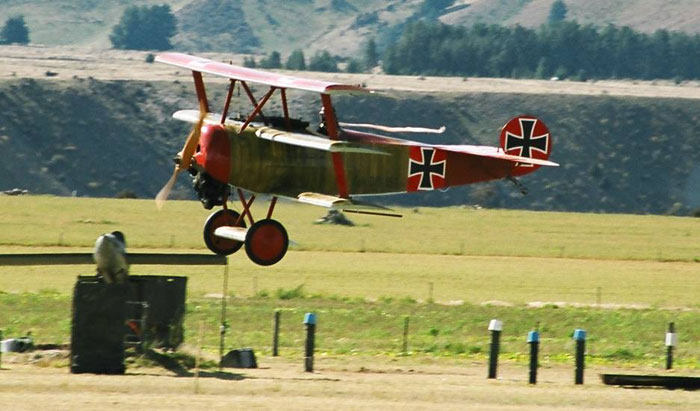 |
|
Another of the Omaka Fighter
Collection’s replicas, this time the instantly recognisable Fokker Dr.1
Triplane. The ‘Tripe’ put in a sprightly flying display, especially with
its climbing abilities compared to the other WW1 replicas. Note the
‘temporal anomaly’ as it overflys a replica V1 flying bomb in the
background. |
We rejoined the other half of the tour at the winery and had a late lunch, well
washed down by the products of the winery.
Our final overnight stop on tour was in Blenheim, again quick forays made to
local toy/hobby and book shops, a well as the more ‘touristy’ locations.
The final day of the tour saw us head from Blenheim back to Christchurch,
stopping at a few sights along the way, as well as making a lunch stop at a
small winery. Some sampling of the winery’s product, accompanied by some fine
local food, provided a near perfect end to the tour. And so we found ourselves
back in Christchurch where our tour began. Our APT Tour coach driver, Geoff, was
a real ‘find’, very knowledgeable on New Zealand’s history, local flora and
fauna, and was able to safely navigate a full size tour coach on roads and
bridges that would have me cringing in a normal sized sedan!
The Saturday was spent doing various things by all those on the tour, again
independent sight seeing was the order of the day. In our case the morning was
spent taking the gondola ride to the top of a local mountain to get a great
overall view of Christchurch and the nearby port of Lyttleton. A great photo
opportunity.
The afternoon however saw me venture out to the RNZAF Museum at Wigram. By
chance there was a major remote controlled aircraft flying meet taking place, so
that provided some aerial action to accompany the visit to the Museum. On the
tarmac outside the Museum, facing towards the active runway, a retired RNZAF
Hawker Siddley Andover sits slowly weathering away. The Museum itself is very
well set out, giving a good overall appreciation of the history of the RNZAF and
the many aircraft it has flown and conflicts it has been involved with. On
entering the Museum, the first thing you are greeted with is one of the RNZAF’s
recently retired A-4 Skyhawks, along with a pair of de Havilland products strung
from the ceiling in flying poses, a d.h.82 Tiger Moth in all yellow trainer
scheme and a Vampire FB.5, along with a Bleriot X1-2 monoplane. A series of
display cabinets containing photographs, memorabilia, model aircraft and
documents relates the RNZAF’s history and activities in different theatres of
operations in peace and wartime. The main aircraft display hall includes a Avro
626 biplane trainer, Avro Anson, Bell UH-1H Iroquois, GAF Canberra B.20, Grumman
TBF-1C Avenger, Lockheed Hudson Mk.III, North American Harvard Mk.3, North
American P-51D Mustang, Supermarine Spitfire LF Mk.XVIE, Douglas C-47B Dakota in
VIP markings, Auster Mk.7, DHC-2. Beaver and a range of other equipment
including bomb trolleys, aircraft tugs and anti aircraft weapons. They also have
a number of simulators scattered around the display areas representing Skyhawk,
Spitfire, Vampire and Mosquito aircraft, with varying degrees of functionality
or simulation.
The real joys are hidden away however, and you need to go on one of the regular
guided tours to their restoration and storage hangers alongside the main Museum
complex. In the restoration hanger, they currently have an Airspeed Oxford,
Vickers Vildebeest, Sopwith Pup replica and Curtiss P-40E Kittyhawk under
restoration, with the P-40 being well advanced. In the storage hanger they have
a range of aircraft, aircraft components, aircraft engines – including
ex-technical instruction cut away engines – and other assorted bits and pieces
of associated equipment, such as a WW2 searchlight and generator trailer.
Dominating the storage hanger is a Bristol Mk.31 Freighter, with the main
fuselage of a Canberra B(1)8 and Consolidated Catalina under its wingspan. Also
tucked in is a seaplane maintenance launch, a reminder of the days when the
RNZAF operating other flying boats, such as the Short Sunderland. An early CT-4
Airtourer trainer, a d.h. Vampire T11 trainer, a Westland Wasp and a Kaman
Seasprite helicopter add some variety. A d.h. Devon navigation trainer in a
maintenance diorama also adds to the interest, as does a BAC Strikemaster. An
odd one in the collection is an ex-USAF Cessna O-2A FAC aircraft, marking the
involvement of RNZAF pilots in the FAC role in Vietnam. The aircraft engines and
jets along the walls give an idea of the progress made in the propulsive methods
of aircraft over many years, and a Bristol Centaurus is one of the larger
exhibits, along with Rolls-Royce Merlin and Allison V-1710 engines. Again so
much to photograph, to some degree hampered by the very crowded state of the
storage hanger. The tour guide on our tour was quite knowledgeable, but had his
own favourite, being an ex-RNZAF Catalina man. Throughout I found all the staff
at the RNZAF Museum at Wigram to be friendly, knowledgeable and most helpful.
They have an archives section that is not open on weekend, but which can be
visited weekdays by appointment.
Sunday was our final day, flying back to Sydney and thence onwards to Canberra
later in the day. So we arrived back home, tired, happy and with a bagful of
great memories and photographs and new friends.
Click the thumbnails below to view
the images full-sized.
Use your browser's Back Arrow to return to this page:
 |
One of the restorations underway at the Croydon Aircraft
Company, being a de Havilland Fox Moth. |
 |
The Breitling Fighters foursome pass overhead in an
immaculate diamond formation, not an easy task with four aircraft with
dissimilar handling and performance characteristics. |
 |
The Breitling Fighters swing around in line abreast for
another pass across the front of the crowd at Wanaka |
 |
Instantly recognisable, the Supermarine Spitfire Mk.XVI
certainly showed its thoroughbred lines. |
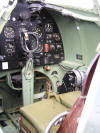 |
The cockpit of the Spitfire, the office that was kept busy
throughout the weekend. |
 |
The Curtiss P-40 Kittyhawk of the Breitling Fighters taxis
out for another flying session. Finished in an AVG scheme it was colourful
and attracted a lot of attention. |
 |
The other Curtis P-40 flying during the weekend was finished
in an RAAF Pacific Theatre colour scheme, and helped provide another high
light of the weekend, a P-40 pair rolling around the sky over Wanaka.
Allisons in STEREO. Seen here with a fuselage access hatch open for
maintenance work before a flight. |
 |
The Breitling Fighters P-51D lands back at the end of
another successful flight with the other members of the quartet. |
 |
Also flying during the weekend was this local P-51D in the
colours of the RNZAF from the 1950’s. It also performed a paired routine
with the Breitling P-51. |
 |
One of the Polikarpovs I-15s seen here on the flight line at
Wanaka. |
 |
One of my favourites and that of the crowd, the New Zealand
Fighter Fighter Pilot Museum’s Hawker Hurricane Mk.I. It is painted in a
representative scheme from the time it served in France during 1940. Here it
taxis back in after one of its performances. Note the ’hostile’ submarine in
the background, later dealt with most effectively by the Catalina. |
 |
A trio of Harvards roll over the top during their display. A
horde of Harvards growled their way around the sky all weekend and provided
a reminder of the sterling service performed by this advanced trainer during
WW2. Their distinctive engine note and prop note meant that they could not
be missed. |
 |
The RNZAF’s B757 put on a brilliant handling display,
performing both low speed and high speed passes, as well as some manoeuvres
that would have certainly upset the passengers – if any had been carried.
The high speed pass and pitch up departure, topping out around 8,000 to
10,000 feet AGL was impressive. |
 |
Lockheed C130 Hercules of the RNZAF makes a tactical
approach for a very short field landing. The engine reverberation from full
reverse pitch and thrust set off car alarms in the car park. |
 |
Crop duster action from the Wanganui Aero Works trio of
Crescos who put on a very spirited and amazing display of flying. Here one
of the trio does a very short landing followed by a reverse thrust back up
along the runway. Note another of the trio passing by at low level in the
first aircraft’s smoke. |
 |
The Consolidated PBY Catalina performs a stately flyby of
the crowd at Wanaka before disposing of the ‘hostile’ submarine that put in
an unwelcome appearance. |
 |
The dissimilar jet foursome of L.39 Albatros, Cessna A-37
Dragonfly and two d.h. Vampires. A great performance from jet aircraft with
very different characteristics. |
 |
A historic pair perform a flyby, the Hawker Hurricane and
Supermarine Spitfire provide a sight and sound once experienced, never
forgotten. |
 |
One of the noisier participants at Wanaka was this T-28
Trojan, seen here taxiing back to the flight line after the completion of
its flying display. |
 |
The author, Colin Ford, gets his opportunity to get a
photograph with the Hawker Hurricane at Wanaka. On the other side of the
lens for a change. |
Text & Images Copyright ©
2004 by Colin Ford
Page Created 27 June, 2004
Last Updated
26 June, 2004
Back to Reference Library
|
Home |
What's New |
Features |
Gallery |
Reviews |
Reference |
Forum |
Search